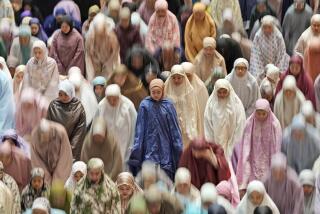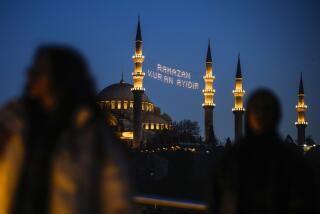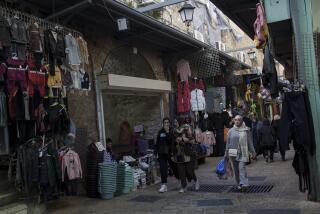Fez Offers a Glimpse Back at Middle Ages
- Share via
FEZ, Morocco — There was a time not so long ago when Europe represented the ultimate destination in the average traveler’s repertoire. Today it is possible to span not only oceans but centuries--waking in a highly developed technological society and going to bed in a land whose inner cities have changed little since the Middle Ages. Morocco, a country of deserts and mountains, of minarets and mosques, is one such place.
Throughout Morocco are cities and towns that had as their origin a cluster of winding streets and alleys in which the whole life of the community--religious, commercial and residential--was concentrated. Over time, as the villages grew, they expanded outward, gradually changing but leaving the original core much as it had always been.
In the major cities are high-rise buildings and blocks of modern apartments, more European that North African. Even here, however, one can turn from a wide boulevard congested with cars into a neighborhood that is a living remnant of the past. This medieval part of the city is called the medina, and nowhere is the medina more colorful, more romantic, more fantastic than in the imperial city of Fez.
Passing through one of the massive gates in the ancient walls that enclose the Fez medina is to plunge into a bombardment of sights, sounds and smells. In the midst of a bustling throng, donkeys and burrows carrying enormous loads are urged forward by shouting men. The crowd parts, pressing against the walls to let the animals lurch by, then regroup and hurry on.
Through open doors, dark hallways lead to tiled stairs rising to apartments above. Tiny barred windows are kept shut, and behind them thousands of people live and work, imparting the sense of a world unseen. This impression disappears at one of the many souks or marketplaces. Each craft has its designated area, and here the doors are flung open to reveal cubicles lit by bare bulbs and crammed with merchandise.
In a little arcade between the butchers’ street and the shoemakers’ street is a series of stalls that sell nothing but thread wound on long spools tied together in starburst patterns and hung from the ceiling in colorful displays. The shoemakers, too, make designs of their wares, tucking one richly brocaded slipper into another, forming bright rows of soft pointed shoes. The butchers on the other hand stick to basics, hanging chunks of meat from hooks, unrefrigerated, while piling hoofs, jawbones and other unappealing parts on plain wooden counters.
Bargaining is a way of life in Morocco, a time-honored custom involving diplomacy, theater, philosophy and the exchange of news and gossip. The seller asks much more than he expects to receive and the buyer offers much less than he expects to pay. To set a fixed price is unheard of, almost scandalous, but for foreigners who do not appreciate the ritual, there is a shortcut. They can decide what the item is worth, offer less and quickly come up to their price. It will undoubtedly be more than the merchant would have settled for but he will accept, somewhat ruefully, because though he has a few extra dirhams in his pocket, he will have been denied the satisfaction of the struggle.
Within the Fez medina are highlights that must not be missed, one of which is signaled by a distinct odor. This is the tannery, and approaching it, guides dispense mint leaves for visitors hold to their noses to counteract the smell. Then they enter a passageway that opens suddenly on a large yard whose floor is a series of connected earthen vats built up to a height of 3 or 4 feet and filled with various liquids.
Bare-legged men walk the edges, climbing in and out, while small black burrows wait motionless to the side. The men take sheep and goat skins and immerse them in a green liquid to remove the hair. Then they place them in a solution of diluted bird droppings--hence the smell--to make them supple. Next they dye them red, yellow or gray and pile them in layers on the burrows who stand patiently until they are led to the drying area.
Re-entering the labyrinth, the inexorable flow of traffic passes tiled fountains carved into the walls where children pull themselves up to fill plastic bottles, past veiled and hooded women carrying circular loaves of dough to the baker for cooking in his ovens, past garbage burrows into whose saddle baskets men shovel refuse from the surprisingly clean streets. Occasionally two donkeys piled high with merchandise meet head on, jamming the passage until their owners yank and prod them free, while pedestrians look to their toes.
In the leather souk, men’s wallets and belts and women’s bags of all sizes cram every available inch of the cubicles on both sides. In the silver market, dishes, trays and lamps gleam as they frame shop after shop. Further on are stores with dates, figs, raisins and nuts, mounds of them, waiting to be weighed and scooped into paper bags.
The henna souk is a small open square where cosmetics are sold in their natural form, mascara in black chunks as well as irregular pieces of incense and tiny vials of perfume. The henna itself is an inexpensive plant, which women grind into powder and make into a paste to use not only for tinting hair, but also as a dye for tatooing intricate and delicate designs on their hands.
Another square, the Place Seffarine, is strewn with heavy metal caldrons and filled with the sound of incessant banging as brass and copper workers make buckets, samovars and platters. In the Nejjarine Place, carpenters create cabinets and bedsteads and cedar tables amid a cloud of sawdust and shavings. Young boys turn lathes with bows like Indians making fire, and etch patterns into the spinning dowels with chisels guided by bare toes.
In the midst of the hubbub of traffic and trade, religion may seem far removed to an outsider, but in fact one is never out of sight of a minaret or beyond the call of a muezzin. In the heart of the Fez medina is at once the largest mosque in North Africa and possibly the oldest university in the world, the Karaouyyine. Founded in 859 by the daughter of a wealthy merchant, it became a center of learning for scholars from the Islamic world and Europe as well.
Enlarged and embellished through the years, by 1135 it was claimed to be capable of receiving 20,000 worshipers. Unfortunately the vast interior is forbidden to non-Muslims, but from the busy street one can look through an arched doorway to an open court and catch a glimpse beyond of a huge columned room, ornate, richly tiled, serene and cool.
In the 13th and 14th centuries, several medersas or religious schools were founded and these are open to the public. The best known are the Attarine and the Bou Inania, whose caretakers guide visitors through marble courts, under arches dripping with stucco stalactites, into rooms with carved cedar ceilings and walls of tile, patterns upon patterns, profuse and endlessly intricate.
In the floors above, ornamentation is absent from the tiny rooms where students lived and studied and received their rations of flat bread through slots cut into the walls. In appearance and atmosphere these cells are strongly reminiscent of French and Italian monasteries of the Middle Ages.
From the roofs of the medersas the view encompasses the entire ceiling of the medina. Above the public streets, women hang laundry and spread grain to dry and have the freedom to socialize with their neighbors and friends. Morocco is still very much a society behind the veil, and women especially have clearly defined codes of behavior, based largely on restrictions and taboos.
There is a shrine in the medina, the tomb of Idress II, the builder of Fez, which is particularly favored by women. It has an ornate gateway leading to a prayer room and is the holiest place in the city. The faithful come all day long and place their hands in a golden hole in the wall to touch the back of the tomb with the hope of receiving baraka, the special blessing or good fortune associated with the saint.
The word baraka, and the concept of good luck through divine grace, is a pervasive part of Moroccan life. Though good fortune may seem in short supply in the medina, what is strikingly missing in the welter of human activity is a feeling of oppression. That there is poverty is obvious, but men and women work with a sense of purpose. Relationships to each other and to their religion are preordained, and there is the security of being a member of a society that has not yet been disrupted by change and the shaking of belief.
How long this will be true no one can say, but for now each resident of the Fez medina knows that he or she is part of a centuries-old tradition, a continuity that gives meaning to their lives. Perhaps that knowledge is reflected in the greeting, “Yom el baraka” --”Truly this is the day of grace.”
More to Read
Sign up for The Wild
We’ll help you find the best places to hike, bike and run, as well as the perfect silent spots for meditation and yoga.
You may occasionally receive promotional content from the Los Angeles Times.






